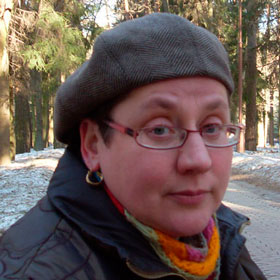Palina Stsepanenka: It seemed to me they would shoot us all...
Human rights activist and writer Palina Stsepanenka-Kachatkova recalls Dziady in 1988 and the human rights advocacy at the time.
Radio “Racyja”: Yesterday we got some sad news – a 25 -year-old human rights activist Viktoryia Starastsenka was killed in Minsk. Is it dangerous to be a human rights defender in Belarus?
Palina Stsepanenka: Yes, it is dangerous to be a human rights defender at all. International human rights forums always begin with a moment of silence, as human rights activists work in the hottest spots, have to deal with various hazards and are often opposed to the state. Their work is especially dangerous in countries with authoritarian and totalitarian regimes.
RR: In Belarus, human rights activists are often imprisoned. It is worth to mention the well-known human rights activist Ales Bialiatski, through whom you have come to the human rights activities.
PS: I really started dealing with human rights advocacy thanks to Ales Bialiatski.
RR: This was back in the 1990-ies when many things happened. However, I would like to go back to the first mass rally in Minsk, from which the changes started – Dziady 1988 ... Did you attend it?
PS: Yes, I was at the rally in 1988. Moreover, I was at the first Dziady, held in 1987 in the Kupala park. This is now rarely mentioned. In the last year of his life the writer Kanstantsin Tarasau wrote short memories of the early Dziady, which can be found on the Internet. Kasia Kamotskaya sang there and poet Anatol Sys read the list of the repressed Belarusian politicians and writers. It was a small event, and I could not even imagine that in a year there would be a mass rally. We, students, pasted leaflets with invitations to Dziady on lamp-posts. All our hands were in the synthetic glue. But I was very impressed when we went to the metro station "Uskhod" and saw many, many people who moved to the Maskouskiya (Uskhodniya) cemetery.
RR: The media reported that people were beaten during Dziady.
PS: It was the first brutally dispersed rally in the USSR. It was there that we first saw the police grab people in the streets and drag them into cars. It was a shock. In my eyes they dragged Ales Bialiatski into a police car. His face flooded with tears. I did not realize it was from the tear gas, "Prunus", which was used by the police. The detention of Ales Bialiatski occurred at the intersection of Lenin Avenue and Kalinouski Street... Then it got very scary near Uskhodniya cemetery, the crowd was very dence. There was a crush, water cannons appeared ... It seemed to me that all of us would be shot.
RR: The changes in Belarus and in the Soviet Union started from those Dziady, at which the police violently broke up a peaceful demonstration... The developments were rather quick... Then you took up the study of literature at the Museum of Maksim Bahdanovich ... and also with Ales Bialiatski... you did not just work in the museum, you were creating it.
PS: The establishment of the museum started in 1981, without ut. When we got to the museum, there were already working such high-level professionals as Vera Mikuta, Tatsiana Shubina, Valiantsina Bialiauskaya... Very experienced and honest people.
RR: Purely museum activities was followed by social ones ... How do you remember that time ?
PS: This was the best time in my life. The museum also hosted the editorial offices of the newspaper "Svaboda" edited by Ihar Hermianchuk, then – the editorial office of "Nasha Niva" edited by Siarhei Dubavets. The Human Rights Center "Viasna" was actually created in the museum as well. In 1996, when arrests started during the mass events, the first parcels to the detention facility in Akrestsin Street were brought from the museum.
RR: You are one of the authors of the documentary book about the tragedy in Niamiha when on 30 May 1999 53 people were trampled in the subway, when hiding from the rain. You have talked with witnesses, their friends and the families of victims. I think it's very hard, back-breaking work...
PS: This work was thankful. Tatsiana Reviaka, Tatsiana Snitko and I wanted to preserve the memory of the victims and the families of the victims understood it. We were treated very well. This work can not be compared in terms of the severity in the moral respect with the work in the campaign "Human rights activists against the death penalty", where we have to deal with the families of those sentenced to death, which is very difficult ... We must find the strength.
RR: Why did you take up the topic of the death penalty?
PS: During the war my grandmother was on death row in Homel. She was only saved by the liberation of the city. But not only that. The death penalty is a murder, even when a murderer is killed. Any murder increases the amount of evil in the world. We should not look to the killers and kill.


















